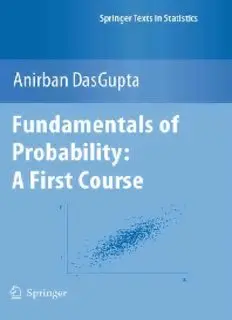
Fundamentals of Probability: A First Course PDF
Preview Fundamentals of Probability: A First Course
Springer Texts in Statistics SeriesEditors: G.Casella S.Fienberg I.Olkin Forothertitlespublishedinthisseries,goto http://www.springer.com/series/417 Anirban DasGupta Fundamentals of Probability: A First Course 123 AnirbanDasGupta PurdueUniversity Dept.Statistics&Mathematics 150N.UniversityStreet WestLafayetteIN47907 USA [email protected] EditorialBoard GeorgeCasella StephenFienberg IngramOkin DepartmentofStatistics DepartmentofStatistics DepartmentofStatistics UniversityofFlorida CarnegieMellonUniversity StanfordUniversity Gainesville,FL32611-8545 Pittsburgh,PA15213-3890 Stanford,CA94305 USA USA USA Mathematica(cid:2)R isaregisteredtrademarkofWolframResearch,Inc. ISSN1431-875X ISBN978-1-4419-5779-5 e-ISBN978-1-4419-5780-1 DOI10.1007/978-1-4419-5780-1 SpringerNewYorkDordrechtHeidelbergLondon LibraryofCongressControlNumber:2010924739 (cid:2)c SpringerScience+BusinessMedia,LLC2010 Allrightsreserved.Thisworkmaynotbetranslatedorcopiedinwholeorinpartwithoutthewritten permission of the publisher (Springer Science+Business Media, LLC, 233 Spring Street, New York, NY10013, USA),except forbrief excerpts inconnection with reviews orscholarly analysis. Usein connectionwithanyformofinformationstorageandretrieval,electronicadaptation,computersoftware, orbysimilarordissimilarmethodologynowknownorhereafterdevelopedisforbidden. Theuseinthispublicationoftradenames,trademarks,servicemarks,andsimilarterms,eveniftheyare notidentifiedassuch,isnottobetakenasanexpressionofopinionastowhetherornottheyaresubject toproprietaryrights. Printedonacid-freepaper SpringerispartofSpringerScience+BusinessMedia(www.springer.com) To theMemoryof WilliamFeller,whose booksinspiredmyloveofprobability,andto DevBasu,thegreatest teacherIhaveknown Preface Probability theory is one branch of mathematics that is simultaneously deep and immediatelyapplicableindiverseareasofhumanendeavor.Itisasfundamentalas calculus.Calculusexplainstheexternalworld,andprobabilitytheoryhelpspredict a lot of it. In addition, problems in probability theory have an innate appeal, and the answers are often structured and strikingly beautiful. A solid background in probabilitytheoryandprobabilitymodelswillbecomeincreasinglymoreusefulin the twenty-first century, as difficult new problems emerge, that will require more sophisticatedmodelsandanalysis. Thisisatextonthefundamentalsofthetheoryofprobabilityatanundergraduate orfirst-yeargraduatelevelforstudentsinscience,engineering,andeconomics.The only mathematicalbackgroundrequiredis knowledgeof univariate and multivari- ate calculus and basic linear algebra. The book covers all of the standard topics in basic probability, such as combinatorial probability, discrete and continuous distributions, moment generating functions, fundamental probability inequalities, the central limit theorem, and joint and conditional distributions of discrete and continuousrandomvariables.But italso hassome uniquefeaturesand a forward- looking feel. Some unique features of this book are its emphasis on conceptual discussions,alivelywritingstyle,andonpresentingalargevarietyofunusualand interestingexamples;carefulandmoredetailedtreatmentofnormalandPoissonap- proximations(Chapters6and10);betterexposuretodistributiontheory,including developing superior skills in working with joint and conditional distributions and thebivariatenormaldistribution(Chapters11,12,and13);acompleteandreadable accountoffiniteMarkovchains(Chapter14);treatmentofmodernurnmodelsand statisticalgenetics(Chapter15);specialeffortstomakethebookuser-friendly,with unusuallydetailedchaptersummaries,andaunifiedcollectionofformulasfromthe text,andfromalgebra,trigonometry,geometry,andcalculusintheappendixofthe book,forimmediateandeasyreference;anduseofinterestingUseYourComputer simulationprojectsaspartofthechapterexercisestohelpstudentsseeatheoretical resultevolveintheirowncomputerwork. Theexercisesetsformaprincipalassetofthistext.Theycontainawidemixof problemsat differentdegreesof difficulty. While many are straightforward,many othersarechallengingandrequireastudenttothinkhard.Theseharderproblemsare alwaysmarkedwith an asterisk. Thechapterendingexercisesthatare notmarked vii viii Preface with an asterisk generally require only straightforward skills, and these are also essentialforgivingastudentconfidenceinproblemsolving.Thebookalsogivesa setofsupplementaryexercisesforadditionalhomeworkandexampreparation.The supplementaryproblemsethas185wordproblemsandaverycarefullydesignedset of120true/falseproblems.Instructorscanusethetrue/falseproblemstoencourage students to learn to think and also quite possibly for weekly homework.The total numberofproblemsinthebookis810. Studentswhotakeacoursefromthisbookshouldbeextremelywell-preparedto takemoreadvancedprobabilitycoursesandalsocoursesinstatisticaltheoryatthe levelofBickelandDoksum(2001),andCasellaandBerger(2001).Thisbookalone shouldgivemanystudentsa solid workingknowledgeof basic probabilitytheory, together with some experience with applications. The sections in the text that are markedwithanasteriskareoptional,andtheyarenotessentialforlearningthemost basictheoryofprobability.However,thesesectionshavesignificantreferencevalue, andinstructorsmaychoosetocoversomeofthemattheirdiscretion. The book can be used for a few different types of one-semester courses; for example,acoursethatprimarilyteachesunivariateprobability,acoursethatcaters tostudentswhohavealreadyhadsomeunivariateprobability,oracoursethatdoes abitofboth.Thebookcanalsobeusedtoteachacoursethatdoessometheoryand thensomeapplications.Afewsuchsampleone-semestercourseoutlinesusingthis bookare: Sample course one: Univariate and some urn models Sections 1.1–1.5; 2.1; 3.1–3.4;4.1–4.9,4.10.1;6.1–6.7;7.1–7.5;7.7.1;8.1–8.4;9.1–9.4;10.1–10.5,10.7; 15.4,15.5 Sample course two: Mostly multivariate, with Markov chains and some urn models A four week review of univariate probability, followed by Sections 11.1–11.5;12.1–12.6;13.1–13.5;8.6;14.1–14.6;15.1,15.2,15.4–15.6 Sample course three: Univariate, discrete multivariate, some Markov chains, and genetics Sections 1.1–1.5; 3.1–3.4; 4.1–4.6, 4.8, 4.9, 4.12; 6.3, 6.4, 6.6, 6.7, 6.9; 7.1, 7.3–7.5, 7.6.1; 8.1–8.6; 9.1–9.4; 10.1–10.4; 11.1–11.4; 14.1–14.3; 15.7–15.9. Acompanionsecondvolumeofthisbookisplannedforlate 2010.Thesecond volumewillcaterprimarilytograduatestudentsinmathematics,statistics,andma- chine learning and will coveradvanceddistribution theory,asymptotictheory and characteristicfunctions,randomwalks,Brownianmotionandtheempiricalprocess, Poissonprocesses,extremevaluetheoryandconcentrationinequalities,asurveyof models,includingmartingales,copulas,andexponentialfamilies,andanintroduc- tiontoMCMC. Peter Hall, Stewart Ethier, Burgess Davis, B.V. Rao, Wei-Liem Loh, Dimitris Politis,YosiRinott,SaravandeGeer,JayaramSethuraman,andRabiBhattacharya made scholarly comments on various drafts of this book. I am thankful to all of them. I am specifically deeply indebted to Peter Hall for the extraordinarynature ofhiscounselandsupportandforhisenduringandselflessfriendshipandwarmth. Preface ix I simplycouldnothavewritten thisbookwithoutPeter’shelpandmentoring.For this,andforbeingauniquecounselorandfriendtome,IamgratefultoPeter. I also want to express my deep appreciation for all the help that I received fromStewartEthierasIwaswritingthisbook.Stewartwasmostgracious,patient, thoughtful,andkind.BurgessDavisaffectionatelyreadthroughseveralpartsofthe book,correctedsomeerrors,andwasatrustedcounselor.Eightanonymousreview- ersmadesuperbcommentsandhelpedmemakethisabetterbook.Springer’sseries editors,PeterBickel,GeorgeCasella,SteveFeinberg,andIngramOlkin,helpedme ineverypossiblewayatalltimes.Iamthankfultothem. John Kimmel, as always, was a pleasure to work with. John’s professionalism and his personal qualities make him a really dear person. My production editor SusanWestendorfgraciouslyhandledeveryproductionrelatedissueanditwasmy pleasuretoworkwithher.MycopyeditorHalHenglindidanunbelievablycareful and thoughtful job. Indeed, if it was not for Hal, I could not have put this book outinareadableform.ThetechnicalstaffatSPiTechnologies,Pondicherry,India did a terrific and timely job of resetting the bookin Springer’stextbooktemplate. Doug and Cheryl Crabill helped me with my computer questions and solved my problems with mysterious and magical powers. Shanti Gupta brought me to the UnitedStatesandcaredformeandwasaguardianandamentorformorethan15 years. I miss Shanti very much. Larry Brown, Persi Diaconis, Jon Wellner, Steve Lalley, Jim Pitman, C.R. Rao, and Jim Berger have given me supportand sincere encouragementformanyofmyefforts.Iappreciateallofthem. Human life is unreasonably fragile. It is important that our fondness for our friendsnotremainunspoken.I amthankfulto numerouspersonalfriendsfortheir affection, warmth, and company over the years. It is not possible to name all of them. But I am especially grateful and fortunate for the magnificent and endear- ingsupport,camaraderie,andconcernof someof mybestfriends,JeniferBrown, Len Haff, Peter Hall, Rajeeva Karandikar,T. Krishnan, Wei-Liem Loh, B.V. Rao, HermanRubin,BillStrawderman,LarryWasserman,andDr.JulieMarshburn,MD. TheyhavegivenmemuchmorethanIhavecaredtogiveinreturn.Iappreciatethem andtheirfriendshipmorethanIcanexpress. I had my core training in probability at the fundamental level in Dev Basu’s classesattheISI.InevermetanotherteacherlikeBasu. Iwassimplyfortunateto havehimasmyteacherandtohaveknownhimfortherarehumanbeingthathewas. BasutoldusthatwemustreadFeller.Icontinuetobelievethatthetwovolumesof Felleraretwo all-timeclassics, andit’shardnottogetinspiredaboutthestudyof randomnessonceonehasreadFeller.IdedicatethisbooktoWilliamFellerandDev Basuforbringingmethejoyofprobabilitytheory. But most of all, I am in love with my family for their own endless love for as longasIhavelived.Ihopetheylikethisbook. WestLafayette,Indiana AnirbanDasGupta Contents Preface............................................................................... vii 1 IntroducingProbability...................................................... 1 1.1 ExperimentsandSampleSpaces..................................... 2 1.2 SetTheoryNotationandAxiomsofProbability.................... 3 1.3 HowtoInterpretaProbability........................................ 5 1.4 CalculatingProbabilities ............................................. 7 1.4.1 ManualCounting............................................ 8 1.4.2 GeneralCountingMethods................................. 10 1.5 Inclusion-ExclusionFormula......................................... 12 1.6 (cid:2)BoundsontheProbabilityofaUnion............................. 15 1.7 Synopsis............................................................... 16 1.8 Exercises .............................................................. 16 References...................................................................... 21 2 TheBirthdayandMatchingProblems..................................... 23 2.1 TheBirthdayProblem................................................ 23 2.1.1 *Stirling’sApproximation ................................. 24 2.2 TheMatchingProblem ............................................... 25 2.3 Synopsis............................................................... 26 2.4 Exercises .............................................................. 27 References...................................................................... 27 3 ConditionalProbabilityandIndependence................................ 29 3.1 BasicFormulasandFirstExamples.................................. 29 3.2 MoreAdvancedExamples ........................................... 31 3.3 IndependentEvents................................................... 33 3.4 Bayes’Theorem....................................................... 36 3.5 Synopsis............................................................... 39 3.6 Exercises .............................................................. 39 xi xii Contents 4 Integer-ValuedandDiscreteRandomVariables.......................... 45 4.1 MassFunction......................................................... 45 4.2 CDFandMedianofaRandomVariable............................. 47 4.2.1 FunctionsofaRandomVariable ........................... 53 4.2.2 IndependenceofRandomVariables........................ 55 4.3 ExpectedValueofaDiscreteRandomVariable..................... 56 4.4 BasicPropertiesofExpectations..................................... 57 4.5 IllustrativeExamples ................................................. 59 4.6 UsingIndicatorVariablestoCalculateExpectations................ 60 4.7 TheTailSumMethodforCalculatingExpectations ................ 62 4.8 Variance,Moments,andBasicInequalities.......................... 63 4.9 IllustrativeExamples ................................................. 65 4.9.1 VarianceofaSumofIndependentRandomVariables .... 67 4.10 Utilityof(cid:2)and(cid:3) asSummaries..................................... 67 4.10.1 Chebyshev’sInequalityandtheWeakLaw ofLargeNumbers........................................... 68 4.10.2 *BetterInequalities......................................... 70 4.11 (cid:2)OtherFundamentalMomentInequalities.......................... 71 4.11.1 *ApplyingMomentInequalities........................... 73 4.12 TruncatedDistributions............................................... 74 4.13 Synopsis............................................................... 75 4.14 Exercises .............................................................. 76 References...................................................................... 80 5 GeneratingFunctions........................................................ 81 5.1 GeneratingFunctions................................................. 81 5.2 MomentGeneratingFunctionsandCumulants...................... 85 5.2.1 (cid:2)Cumulants................................................. 87 5.3 Synopsis............................................................... 89 5.4 Exercises .............................................................. 89 References...................................................................... 90 6 StandardDiscreteDistributions ............................................ 91 6.1 IntroductiontoSpecialDistributions ................................ 91 6.2 DiscreteUniformDistribution ....................................... 94 6.3 BinomialDistribution................................................. 95 6.4 GeometricandNegativeBinomialDistributions.................... 99 6.5 HypergeometricDistribution.........................................102 6.6 PoissonDistribution ..................................................104 6.6.1 MeanAbsoluteDeviationandtheMode...................108 6.7 PoissonApproximationtoBinomial.................................109 6.8 (cid:2)MiscellaneousPoissonApproximations...........................112 6.9 Benford’sLaw ........................................................114 6.10 DistributionofSumsandDifferences................................115 6.10.1 (cid:2)DistributionofDifferences...............................117
